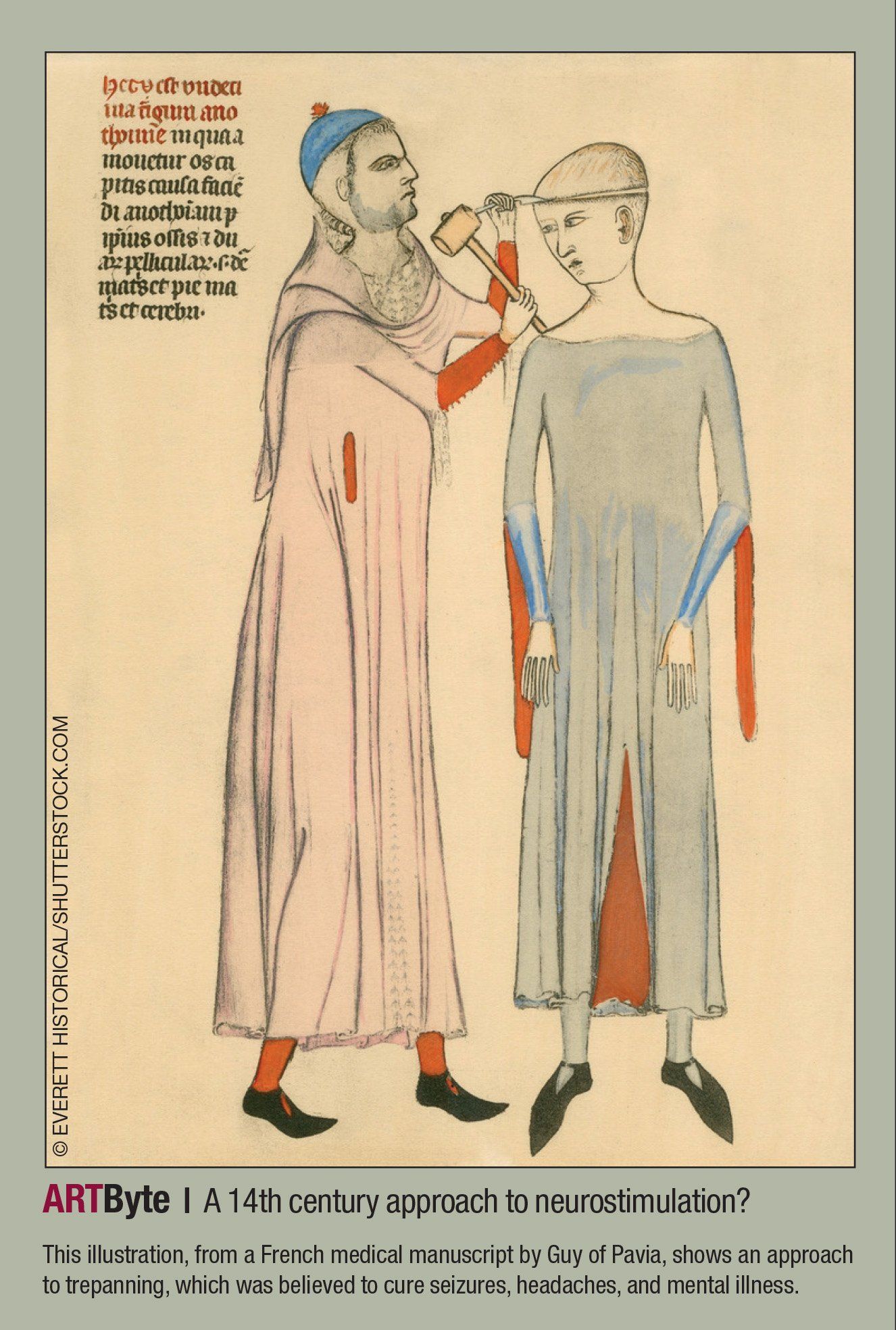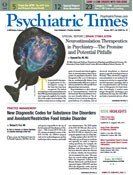Publication
Article
Psychiatric Times
Neurostimulation Therapeutics in Psychiatry -The Promise and Potential Pitfalls
Author(s):
Neurostimulation approaches offer an exciting set of therapeutic alternatives to traditional pharmacotherapy for psychiatric disorders.
© Everett Historical/Shutterstock.com

TABLE. Characteristics of neurostimulation approaches

The potential for therapeutic applications of electromagnetic energy to the brain has long been recognized. The earliest recorded report of neurostimulation was that of Mesopotamian physician Scribonius Largus who applied a live torpedo fish on the scalp to treat headache. The modern era has seen an exciting emergence of research and clinical applications in neurostimulation-based therapeutics for psychiatric disorders. Such therapeutics offer a set of alternatives that are mechanistically distinct from and fundamentally different in mode of delivery and adverse-effect profile from pharmacologic interventions.
Neurostimulation is often referred to as “neuromodulation,” which the International Neuromodulation Society more broadly defines as “the alteration of nerve activity through targeted delivery of a stimulus, such as electrical stimulation or chemical agents, to specific neurological sites in the body.” Thus, electrical or magnetic neurostimulation is one method of altering nerve activity in a targeted fashion and represents a paradigm shift in the conceptualization and development of therapeutics for brain disorders. Accordingly, it confers some unique therapeutic advantages over medications but may also elicit different kinds of potential adverse effects that need to be thoughtfully studied and mitigated.
Neurostimulation approaches
“Targeted fashion” is perhaps the most critical aspect of neurostimulation that distinguishes it from medications, which generally have no substantive neuroanatomic specificity in their application. In contrast, neurostimulation approaches have much better spatial resolution. At a minimum, all brain stimulation methods have limited or no effects “below the neck.”
Some approaches such as standard applications of transcranial direct current stimulation (tDCS) have poor spatial selectivity (centimeters), but the most selective approach in the form of deep brain stimulation (DBS) can have a spatial resolution of approximately 1 mm. Most other neurostimulation approaches have spatial resolutions intermediate to these 2 extremes, with the exception of convulsive approaches (ECT and magnetic seizure therapy).
One of the great advantages of neurostimulation as a therapeutic is the focality of application, which spares other brain regions as well as other organ systems of the body from exposure to the treatment. In addition to differences in spatial resolution, neurostimulation approaches vary in other aspects including their depth of penetration, whether they are invasive or non-invasive, convulsive or non-convulsive, and whether energy is delivered in electric or magnetic form (Table).
While this mechanistically novel and spatially selective array of therapeutics offers a beacon of hope against a backdrop of a relatively poor track record in the development of novel pharmacologic interventions, we should be clear about the underlying assumptions regarding the mode of action. Such clarity will help us in demarcating the potential theoretical limits of therapeutic efficacy, in pointing to potential adverse effects, and in refining treatment parameters as advances in basic and clinical science prompt updating of these assumptions.
Spatial selectivity
The advantage of a spatially selective therapeutic rests on the assumption that there is a well-defined brain region or structure that if stimulated could directly (through involvement in the pathophysiology) or indirectly (by ameliorating a pathophysiologic process even if the region is not itself involved) derive a therapeutic benefit. Limiting stimulation to the targeted brain region would then ideally elicit the desired effect while sparing stimulation of adjacent regions, thereby avoiding any undesirable effects. Such reasoning assumes a certain model of brain function and by extension pathophysiology of the illness being treated. Specifically, the brain is assumed to have a modular organization where the brain is divided into functional anatomically distinct regions and that through over- or under-activation can serve as the pathophysiologic basis for disease states. Accordingly, correcting such altered activations could ameliorate the disease state.
This framework for understanding brain functional organization and pathophysiology has proved useful in the development and application of successful neurostimulation-based therapies for a number of psychiatric disorders. That this simple framework could serve at least as a useful heuristic is remarkable given all of the brain’s known intricacies involving neurochemistry, molecular mechanisms, cellular subtypes, cytoarchitectural organization, connectivity to other regions, etc.
This surprising outcome can be poignantly illustrated by repetitive transcranial magnetic stimulation (rTMS) treatment for refractory depression. This well-established therapy targets the left dorsolateral prefrontal cortex (DLPFC) and is the only FDA-approved noninvasive neurostimulation treatment for refractory depression. That delivery of electromagnetic energy to this critical brain structure might lead to therapeutic effects needs to be appreciated in the context of its connectivity to other brain regions as well as its functional role. It is interesting to note that the effects of rTMS of the DLPFC may be mediated by engagement of the subgenual cingulate cortex, a region that is consistently identified as an important node in the distributed network affected by depression.1 In this study Fox and colleagues found that the strength of functional connectivity between the specific stimulation site in the DLPFC and the subgenual cingulate was correlated with treatment response. Thus, the local stimulation of DLPFC by rTMS appeared to be effective only inasmuch as it was engaging other structures in a broader network implicated in the pathophysiology of depression.
The finding that neurostimulation’s therapeutic effects could be mediated by distal effects downstream to the site of stimulation or perhaps modulating the connectivity with those regions offers an important insight regarding treatment mechanisms. That stimulation of the DLPFC might lead to such therapeutic benefits may be surprising given the important cognitive functions that it supports such as working memory and cognitive control. Discussions of rTMS therapeutic mechanisms in depression at such gross neuroanatomic levels of analysis typically sidestep how such stimulation may affect cognitive functions and the underlying local circuitry. Indeed, rTMS of the DLPFC may be considered to be relatively nonselective given how highly specialized and refined the local circuitry connectivity must be to support such cognitive processes. It may also be surprising that the stimulation of this structure does not obviously disrupt its function but rather can actually enhance its functioning with high-frequency stimulation.2
To further complicate the story, working memory ability involves the ability both to maintain stable representations and to flexibly update them when necessary. It is well recognized that there is a tradeoff between stability and flexibility, with much interest in the neural mechanisms that map to these opposing requirements.3 However, since these mechanisms largely operate at the level of local neural circuitry within the DLPFC, any benefits that may accrue from neurostimulation for stability requirements may come at the expense of flexibility and vice versa. In other words, since this tradeoff may be inherently “built-in,” the spatial selectivity of neurostimulation does not confer the ability to avoid this tradeoff, since it is part and parcel of the functioning of the DLPFC.
The example spelled out here highlights 2 important considerations in the realm of neurostimulation therapeutics. First, the therapeutic effects of stimulation may not be caused solely by local circuit modulation but may be mediated by effects on distal sites and/or modulation of the connectivity of distributed networks. Second, stimulation of a brain region can lead to pleiotropic effects; ie, multiple clinical and cognitive effects -desirable and undesirable -may result.
Conclusion
Neurostimulation approaches offer an exciting set of therapeutic alternatives to traditional pharmacologic treatments for psychiatric disorders. One of the greatest advantages most of the approaches confer is their spatial selectivity that minimizes or avoids effects on non-targeted brain tissue or other organ systems. Given that the modes of delivery and mechanisms of action are so different from pharmacologic approaches, we must utilize a framework that is specifically informed by our understanding of electromagnetic energy and its effects on neural systems. This will help us develop and refine the optimal treatment protocols for enhancing clinical effects as well as properly evaluating and mitigating any potential adverse effects.
Disclosures:
Dr. Cho is Associate Professor, Department of Psychiatry and Behavioral Sciences, The University of Texas Health Science Center, McGovern Medical School, Houston, TX.
References:
1. Fox MD, Buckner RL, White MP, et al. Efficacy of transcranial magnetic stimulation targets for depression is related to intrinsic functional connectivity with the subgenual cingulate. Biol Psychiatry. 2012;72: 595-603.
2. Bagherzadeh Y, Khorrami A, Zarrindast MR, et al. Repetitive transcranial magnetic stimulation of the dorsolateral prefrontal cortex enhances working memory. Exp Brain Res. 2016;234:1807-1818.
3. D’Esposito M, Postle BR. The cognitive neuroscience of working memory. Ann Rev Psychol. 2015;66: 115-142.







